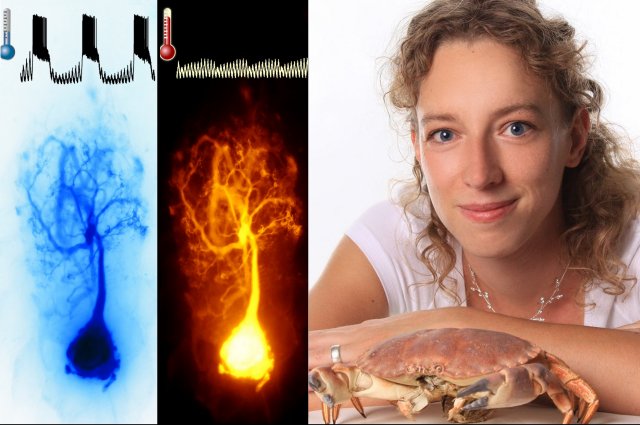Illinois State’s Professor of Neurophysiology Wolfgang Stein and doctoral student Carola Städele have discovered that even a small increase in temperature can have devastating effects on nervous system functions. The team, which includes Stein, Städele, and Stein’s former student Stefanie Heigele from Basel University, has just published findings in the respected PLoS Biology journal.
Städele, a doctoral student, has been working with Stein on the project for nearly five months. She said even a slight rise in temperature can affect nerve cells. “We are not talking a lot, maybe five to seven degrees Fahrenheit,” she said. “That’s similar to a very strong fever.” Scientists have known for years that all biophysical processes are differentially affected by temperature. So the question became, how are nervous systems handling rises in temperature and how do they remain functional?
Stein’s lab works with a species of crabs found on the Atlantic coast from Newfoundland to Florida. Crabs are particularly well-suited for this kind of study since they experience substantial temperature fluctuations in their natural habitat without actively maintaining their body temperature. “One would thus assume that the nervous system should be able to cope with temperature fluctuations,” said Städele. However, the team found that even a small temperature increase by 3 degree Celsius (5-7 degree Fahrenheit) can lead to a termination of vital rhythmic activity when the nervous system is experimentally isolated from the animal. Yet, the intact animal can compensate for these detrimental temperature effects.
The study reveals that nerve cells are not necessarily able to intrinsically compensate detrimental temperature effects. They find that even small temperature changes can disrupt the well-balanced flow of ions across the nerve cell membrane with the result that generation of vital rhythmic neural activity can be severely impaired. This balance-change, however, can be compensated by the release of neuromodulators, small chemical substances that alter nerve cell activity. Städele, Heigele, and Stein found that neuromodulators released from other neurons can restore the balanced flow of ions at elevated temperatures.
“Picture a balloon representing a nerve cell,” said Stein, “even at normal temperatures the balloon has holes letting air out. Simultaneously, the same amount of air leaving the balloon is pushed back in.” When it comes to nerve cells, it is ions and not air flowing in and out, Stein explained. “When temperatures rise, more ions are pushed out than in, which disrupts the balance and makes it difficult for the nerve cell to remain active. If this is affecting vital behaviors, the consequences for an organism can be devastating,” he said. Neuromodulators now function as bandages: they fix the additional holes to restore the ionic balance and thus neuronal activity.
The study is one of few to directly show that when the innate compensation that nerve cells are born with fails, compensation can be achieved via an increased release of neuromodulatory transmitters. The study suggests that temperature compensation via neuromodulation may be a widespread phenomenon, and allows quick and flexible compensation of temperature influences on the nervous system. Studies of neuromodulators may also help to understand why sudden infant death syndrome occurs more frequently in children with elevated body temperatures,” noted Städele/Stein.
The study titled “Neuromodulation to the Rescue: Compensation of Temperature-Induced Breakdown of Rhythmic Motor Patterns via Extrinsic Neuromodulatory Input,” is receiving positive attention throughout the field.

